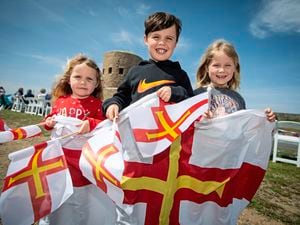Memorial flight poignant for family of wartime navigator
TODAY’S Battle of Britain Air Display memorial flight will be a poignant moment for one Guernsey family.

The day marks the centenary of the birth of former Squadron Leader Ken Delbridge, who was a navigator on Wellington and Lancaster bombers during the Second World War, flying with 431 and 432 Squadrons.
In all 7,377 Lancaster heavy bombers were built at the Vickers Armstrong Broughton factory and one of only two surviving will hopefully be part of today’s display.

Squadron Leader Delbridge died in 2005. Widow Marion, and two of their three sons, John and Jim, will be watching the display with interest today.
‘It’s the most marvellous coincidence,’ said John.
‘To get a Lancaster flying past on this special day is absolutely wonderful and will make us all quite emotional when we see it overhead. Let’s hope the weather is good.’
Squadron Leader Delbridge joined up at Lord’s Cricket Ground aged 18 in 1940. He wanted to be a pilot but because he was good at maths was sent to Florida for training by the Royal Canadian Air Force as a navigator.
Being a crew member of a Lancaster was considered one of the most dangerous jobs in the entire war. The average life expectancy for RAF bomber crews then was six missions, with the average crew member age being just 22.
Squadron Leader Delbridge flew on 29 missions over occupied territory during the war and was awarded the Distinguished Flying Cross.
He survived two crashes during peacetime. In the first, in September 1946, he was in a Wellington training flight that crashed in the English Channel 30 miles north of Guernsey due to fuel problems. Three people were killed and three survived. In December 1947 he fractured his skull and an arm and was unconscious for 10 days after the Lancaster he was flying in overshot a runway at Shawbury and struck a passing car.
After that he stopped flying, co-wrote the RAF navigation manual and became a recruitment officer. He retired from the RAF in 1960 and moved to Marion’s home island of Guernsey.
He became an enthusiastic member and trainer for Civil Defence on the island and took on the role of managing director of the Charroterie Mills timber yard.
The Royal Air Force’s bombing offensive against Nazi Germany was one of the longest, most expensive and controversial of the Allied campaigns during the Second World War. Its aim was to severely weaken Germany’s ability to fight, which was central to the Allies’ strategy for winning the war.





